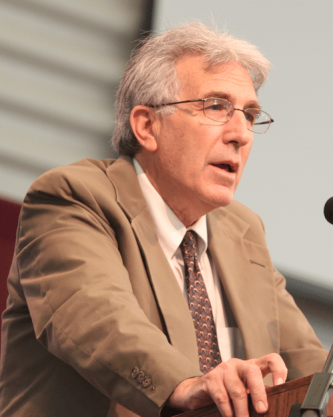There is an unforgettable moment near the end of A Man for All Seasons (a perfectly fabulous film, which won a busload of awards—including Best Picture of the Year in 1966, starring Paul Scofield as the saintly Thomas More). It is the courtroom scene where More, following his betrayal by Master Richard Rich, whose perjured testimony will send him to the scaffold, asks to see the chain of office Rich is wearing. Master Cromwell, chief among the villains of the piece, tells him it signifies his recent appointment as Attorney General for Wales. “For Wales?” asks More, his voice steeped in sarcasm. “Why Richard, it profit a man nothing to give his soul for the whole world…but for Wales?”
I actually thought of that scene the other day when, entirely by accident, I came across an obituary, written in great and admiring detail, about Sister Elizabeth J. McCormack, who died a few months ago at the age of 98. Only by then she was no longer a sister, that apparent youthful indiscretion having been succeeded by a number of strategically shrewd career moves culminating in multiple memberships on the boards of powerful and prestigious foundations, not the least being the Population Council of the Rockefeller Foundation, whose children and cousins she would advise on matters of philanthropy. She certainly kept the Old Guy waiting, and when at last she left this vale of tears, her public life was covered with no end of worldly honor and praise.
But when I first heard of her, back in the late 1960s, she was still Sister Elizabeth, an outwardly faithful daughter for thirty years or more in the Society of the Sacred Heart, a religious order dedicated to the education of young women in the Catholic tradition. To that end, an Academy of the Sacred Heart had been founded in 1841, later becoming Manhattanville College of the Sacred Heart, where young Elizabeth McCormack would later matriculate, so profoundly shaped by its life of learning and piety that by her senior year she had resolved to join the order. So impressive was her rise that by 1966 she had become its sixth president, serving in that office with a kind of swashbuckling style until 1974, which was the year she sought and obtained release from her vows. Soon after, she married a divorced Jewish father of five children.
Orthodox. Faithful. Free.
Sign up to get Crisis articles delivered to your inbox daily
What happened? For one thing, the Blaine Amendment, which was a provision included in the Constitution of the State of New York forbidding state aid from going to religious institutions. To get around that, of course, one simply pulls the plug on every distinctive Catholic feature of the college. And so the wrecking ball began to swing, eventually smashing to bits everything that had been recognizable from the past. “Dismantling the school’s Catholic identity,” noted New York Times reporter Robert D. McFadden in his glowing obituary, “meant dropping the Sacred Heart name and cherished symbols of Christianity, including hundreds of crucifixes.”
What on earth did she do with all those crucifixes? Did she give them away to faithful alumni and students sickened by the thought of all that history swept carelessly away in the general upheaval, the madness of making Manhattanville more amenable to the modern age? No, she did not. Instead, says McFadden, “Ms. McCormack and three young nuns gathered them up from all over campus and, with groundskeepers’ shovels, buried them in the woods behind a playing field.”
Their internment, by the way, did not take place on just any day. She chose Good Friday, the day on which Our Blessed Lord, to whom all those crucifixes testify, was buried. Mr. Charles Kenney, in his book No Ordinary Life: The Biography of Elizabeth J. McCormack, adverts to that particular episode, quoting Ms. McCormack’s brief comment: “We thought it was an appropriate day.”
That will hardly do, of course. Many more than one can blame the Blaine Amendment for the collapse of a once-thriving Catholic college, a pretext, yes, for the demolitions that would inevitably follow. But not the cause. No, the catalyzing agent could only have been then-Sister Elizabeth, her life so sadly upended in the convulsions loosed upon the Church and the world that for the sake of keeping the flow of federal and state grant money going, a whole way of life would have to go—a kind of Faustian bargain, you might say, with the Old Guy himself, tricked out in the fancy dress of enlightenment and progress.
And if you need a flash point of an example to illustrate the darkness that appears to have surrounded and would, in the years to come, obscure her vision entirely concerning what we Catholics call “the permanent things,” there is this sentence in the Times obituary that says it all:
In what the Church regards as a cardinal sin but what she called compassion, she quietly advised a student on how to obtain an abortion.
We don’t know how many more students were similarly advised to kill their children, but in for a penny, as they say, in for a pound. The far more interesting question, however, is to ask—What will become of her now? I mean, on the other side of death, which is a place where earthly esteem means nothing? Where even Rockefeller money has no value. It is not for us to speculate, of course, nor to judge; but to plead for the mercy of God lest she be lost forever. But if there be any hope for her soul at all, I’d like to think it may include a journey—however God and His Angels manage these things—back to those woods behind a playing field in New York, and there amid burning purgatorial fires of sorrow and regret, be made to unearth every blessed one of those crucifixes, symbols of a faith she wishes now she’d never rejected.
